Deriving Temporal and Vertical Distributions of Methane in Xianghe Using Ground-based Fourier Transform Infrared and Gas-analyzer Measurements
Denghui JI, Minqiang ZHOU, Pucai WANG, Yang YANG, Ting WANG, Xiaoyu SUN,Christian HERMANS, Bo YAO, and Gengchen WANG
1Key Laboratory of Middle Atmosphere and Global Environment Observation, Institute of Atmospheric Physics,Chinese Academy of Sciences, Beijing 100029, China
2Royal Belgian Institute for Space Aeronomy, Brussels 1180, Belgium
3University of Chinese Academy of Sciences, Beijing 100049, China
4Meteorological Observation Center, China Meteorological Administration, Beijing 100081, China
ABSTRACT
Key words: methane, Fourier transform infrared spectrometer (FTIR), Picarro, retrieval method, source emissions
1. Introduction
Since the beginning of the Industrial Revolution(1750), human activities have had a huge impact on the concentration of trace gases in the atmosphere. Anthropogenic greenhouse gas emissions from industry and agriculture, the burning of fossil fuels, destruction of surface vegetation,and changes in land type have led to a surge in atmospheric carbon dioxide (CO2), from 280 ppm before the Industrial Revolution to 407.96 ppm in 2018. A rapid growth rate remains apparent. Methane (CH4) rose from 0.722 ppm before the Industrial Revolution to 1.855 ppm in 2018. The increase of greenhouse gases could increase the greenhouse effect, and any increase in the average temperature of the Earth will have a huge impact on its ecosystems. The Intergovernmental Panel on Climate Change (IPCC) reported that a 2°C increase in the Earth’s average temperature will be hazardous (IPCC, 2014), and Mann et al. (2014) predicted that this threshold would be exceeded by 2036. Therefore, monitoring and controlling greenhouse gas emissions is extremely important.
CH4is one of the most important carbon-containing compounds in the atmosphere. The global warming potential(GWP) of CH4is 28 times greater than that of CO2(IPCC,2014). In addition, it is a chemically active gas, which can be oxidized in the atmosphere to form hydroxides and carbon oxyhydroxides. Stratospheric CH4can also react with chlorine atoms generated by photolysis of chlorofluorocarbons, inhibiting the destruction of stratospheric ozone by chlorine atoms (Duncanand Truong, 1955). The lifetime of CH4in the atmosphere is approximately nine years(Kirschke et al., 2013). Considering the GWP and lifetime of CH4, it is important to study the sources and sinks of CH4to learn how to control it.
Generally, sources of CH4can be divided into two types: natural and anthropogenic. Natural sources include wetlands, vegetation, and oceans (Fung et al., 1991). Anthropogenic sources include energy activities (involving coal mining and oil and gas systems), agricultural activities(involving ruminants, rice field discharge, and open burning of straw), waste treatment (of solid waste, industrial waste, and domestic sewage) and constructed wetlands (Janssens-Maenhout et al., 2019). The destructive reaction with the hydroxyl radical (OH) is the biggest sink of CH4in the atmosphere, especially in the troposphere (Heilig, 1994).
Systematic observation of CH4began in the 1880s via the Global Atmospheric Watch (GAW) of the World Meteorological Organization (WMO). Currently, the ground-based high-resolution Fourier transform infrared (FTIR) solar absorption spectrometer plays an important role in remote sensing of trace gases. There are two CH4observation networks in the world: one is the Total Carbon Column Observing Network (TCCON) (Wunch et al., 2011), and the other is the Network for the Detection of Atmospheric Composition Change-Infrared Working Group(NDACC-IRWG)(De Mazière et al., 2018). Both networks exist in Europe,North America, and Japan, and there is currently only one potential additional TCCON site (in Hefei), and no NDACC site in China. In this study, the temporal and vertical distributions of CH4were measured by both the FTIR in-situ techniques at a new site in Xianghe, China.
2. Observation site
Xianghe (39.8°N, 117.0°E) is located in Hebei Province in China, approximately 30 m above sea level and 50 km from Beijing. Figure 1a shows the location of this site, along with EDGAR v4.3.2 (Emission Database for Global Atmosphere Research) emission data (Janssens-Maenhout et al., 2019, Crippa et al., 2018). It is clear that Xianghe is in an area with high CH4emissions, of about 450—1200 tm-2yr-1. Thus, Xianghe is an appropriate site to gather information about CH4sources. It also has a continental monsoon climate, characterized by low precipitation amounts, higher winds and evaporation amounts in the spring, high temperatures, humidity, and intense rain in the summer, relatively less rainfall and calmer weather in the autumn, and cold and dry winds from the north in winter.
We began measuring CH4in June 2018. The sources of CH4are relatively variable and location-dependent. In most parts of the world, natural emissions are the main sources,such as wetlands, termites, oceans, and hydrates (Kaplan et al., 2006; IPCC, 2014; Zhang and Liao, 2015). However,more recently, anthropogenic emissions have come to play an important role (Kirschke et al., 2013). Fugitive emissions from solid fuels, rice cultivation and enteric fermentation are very important in China (Fig. 1b).
3. Instrumentation and methods
3.1. Picarro G2301
The Picarro G2301 gas mole fraction analyzer provides simultaneous and precise measurements of CO2, CH4, and H2O, with a sensitivity of 1 ppb and negligible drift. This instrument is widely used in atmospheric science and air quality applications for quantification of emissions. The G2301 uses WS-CRDS (wavelength-scanning cavity ring-down spectroscopy) to measure the laser ring-down time difference over a path length of up to 20 km with high accuracy (Fang et al., 2012). It meets the WMO and ICOS (Integrated Carbon Observation System) performance requirements for CO2and CH4atmospheric monitoring (Laurent, 2015). The G2301 was fully operational, almost without interruption, during the study period. We use 5-min-averaged CH4data at the surface (90 mMSL) to ensure high accuracy (< 0.7 ppb).
3.2. FTIR spectrometer
We used the Bruker IFS 125HR FTIR to observe CH4in Xianghe, which is the highest-precision instrument among ground-based remote sensing instruments (± 0.9 ppb; Esler et al., 2000). The maximum optical path difference of the FTIR in Xianghe was 180 cm, with a spectral resolution of 0.0035 cm-1. To obtain more observations of trace gases, we used two observation modes: TCCON and NDACC-IRWG. NDACC-IRWG adopts a CaF2beam splitter and an InSb detector with a spectral range of 1800—5400 cm-1, while TCCON uses CaF2and InGaAs with a spectral range of 3900—12000 cm-1. The FTIR works during the day[between 0900 and 1600 local time (LT)]. For each day,there are approximately 40 spectra measured in TCCON observation mode and 5 measured in NDACC observation mode, and these are used to retrieve CH4. Figure 2 shows the typical spectra measured by the two modes. The TCCON and NDACC retrieval strategies, i.e., retrieval windows and interfering species, are shown in Table 1. A specific filter is applied for the InSb spectrato increase the signalto-noise ratio.
3.2.1. Retrieval method

Fig. 1. (a) EDGAR v4.3.2 CH4 anthropogenic emissions in 2012 in China. (b) Annual total Chinese CH4 emissions contributed by eightsectors in 1970—2012.
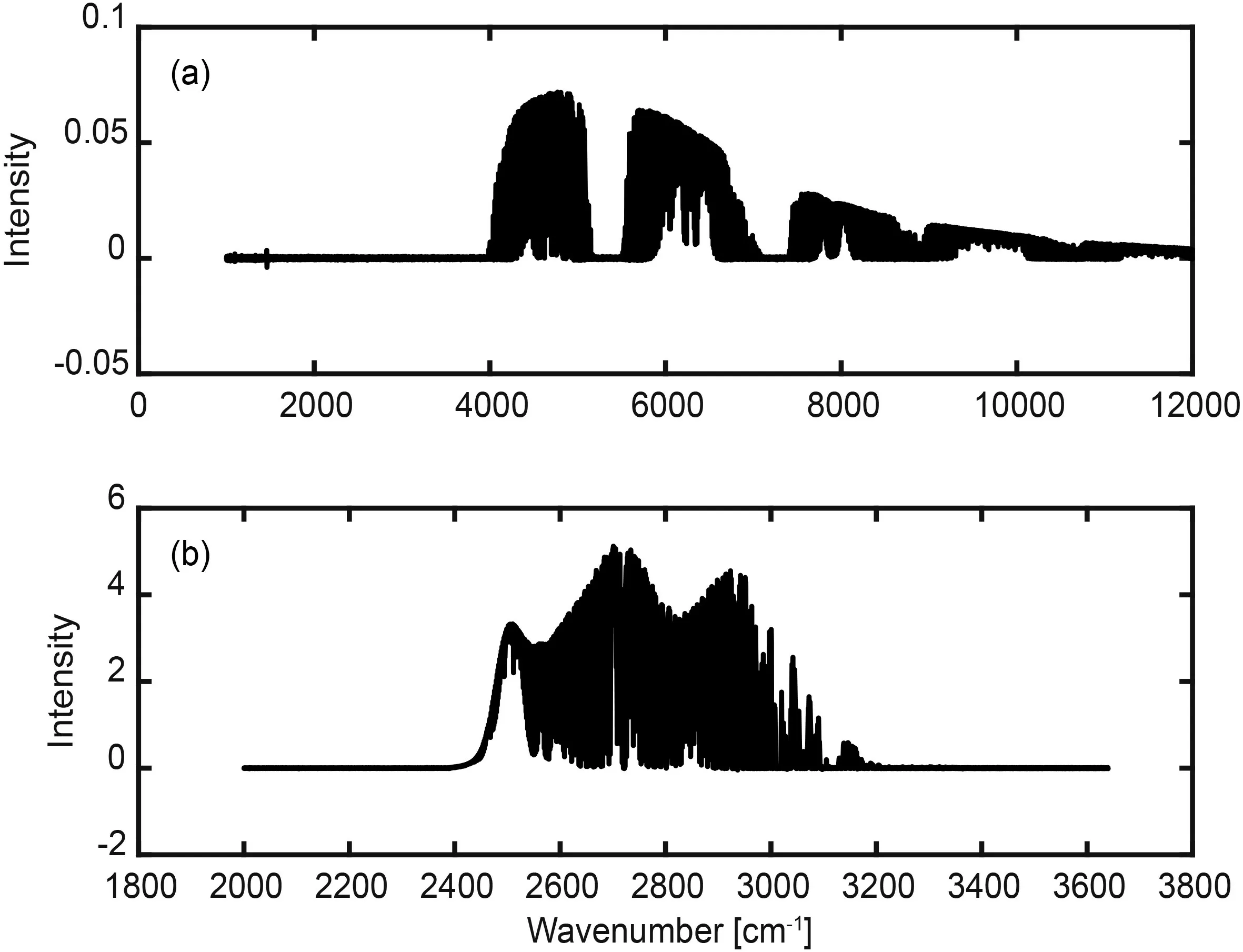
Fig. 2. Spectrum observed by FTIR with (a) InGaAs detector and (b) InSb detector.

Table 1. TCCON and NDACC CH4 retrieval strategies in Xianghe.
The optimal estimation method (Rodgers, 2000) was applied to retrieve gas mole fractions from the FTIR solar spectra. Several software retrieval algorithms are applied for different purposes, such as GGG2014, SFIT, and PROFFIT(Toon et al., 1992; Notholt et al., 1993; Hase et al., 2004).
According to the optimal estimation method, atmospheric radiation transfer can be described by a simple mathematical model, as follows:

where Y is the radiation spectrum, X is the set of unknown atmospheric and surface state quantities, as well as the solar and instrumental parameters that affect the radiation spectrum, b is the set of known atmospheric and surface state parameters, F is the forward-transfer radiation model function,and ε is the error of observation. The inversion process involves taking the observed spectrum (Y) and finding the unknown atmospheric and surface state parameters (X).
To carry out the inversion process, a cost function is defined as:

where the first term on the right-hand side represents the difference between the measured and simulated spectra for a given atmospheric state of X and b, S∈is the noise covariance matrix, the second term on the right-hand side is the regularization term, constraining the atmospheric solution state X to the a priori state Xa, and Sais the a priori covariance matrix. Since most physical processes in the atmosphere are nonlinear, the cost function, Eq. (2), is minimized iteratively by the Levenburg-Marquardt (LM) Gauss—Newton method. Convergence gives the retrieved state vector, xˆ, as follows:

where xais the a priori state matrix, xtis the true state vector, and A is the average kernel (AVK) function matrix, representing the sensitivity of the inversion parameters to the true state of the atmosphere, given by:

In Eq. (4), G is called the contribution function matrix,which indicates the contribution of observed values to inversion values, K is a weight function matrix that expresses the sensitivity of simulated values to input parameters, such as the instrument line functions, and γ is the coefficient in the LM method.
3.2.2. GGG2014 and SFIT4 retrievals
The GGG2014 algorithm was applied to retrieve the column-averaged dry-air mole fraction of CH4( XCH4) from InGaAs spectra. It also performs profile scaling. Specifically, XCH4is obtained from the ratio between the total column of CH4(V CCH4) and O2(V CO2), using the followi ng equation:

where 0.2095 is the volume mixing ratio of O2in dry air(Wunch et al., 2011).
Since there is no O2signal available in the mid-infrared spectrum, and the N2signal is very weak (Zhou et al.,2018), the SFIT4 algorithm calculates the XCH4from the dry-air columnas follows:

where TCH2Ois the total column of H2O, Psis the surface pressure, g is the column-averaged gravitational acceleration, and mH2Oand mair_dryare the molecular masses of H2O and dry air, respectively.
Note that the a priori information is different between GGG2014 and SFIT4. For the meteorological variables of temperature, pressure, and water vapor, both algorithms use NCEP six-hourly reanalysis data. However, the a priori profiles of CH4are obtained by different methods. For GGG2014, the daily profiles are generated by a stand-alone tool based on in-situ and aircraft measurements (Toon and Wunch, 2015). For SFIT4, the profiles are derived from the Whole Atmosphere Community Climate Model (WACCM),version 4 (Zhou et al., 2019).
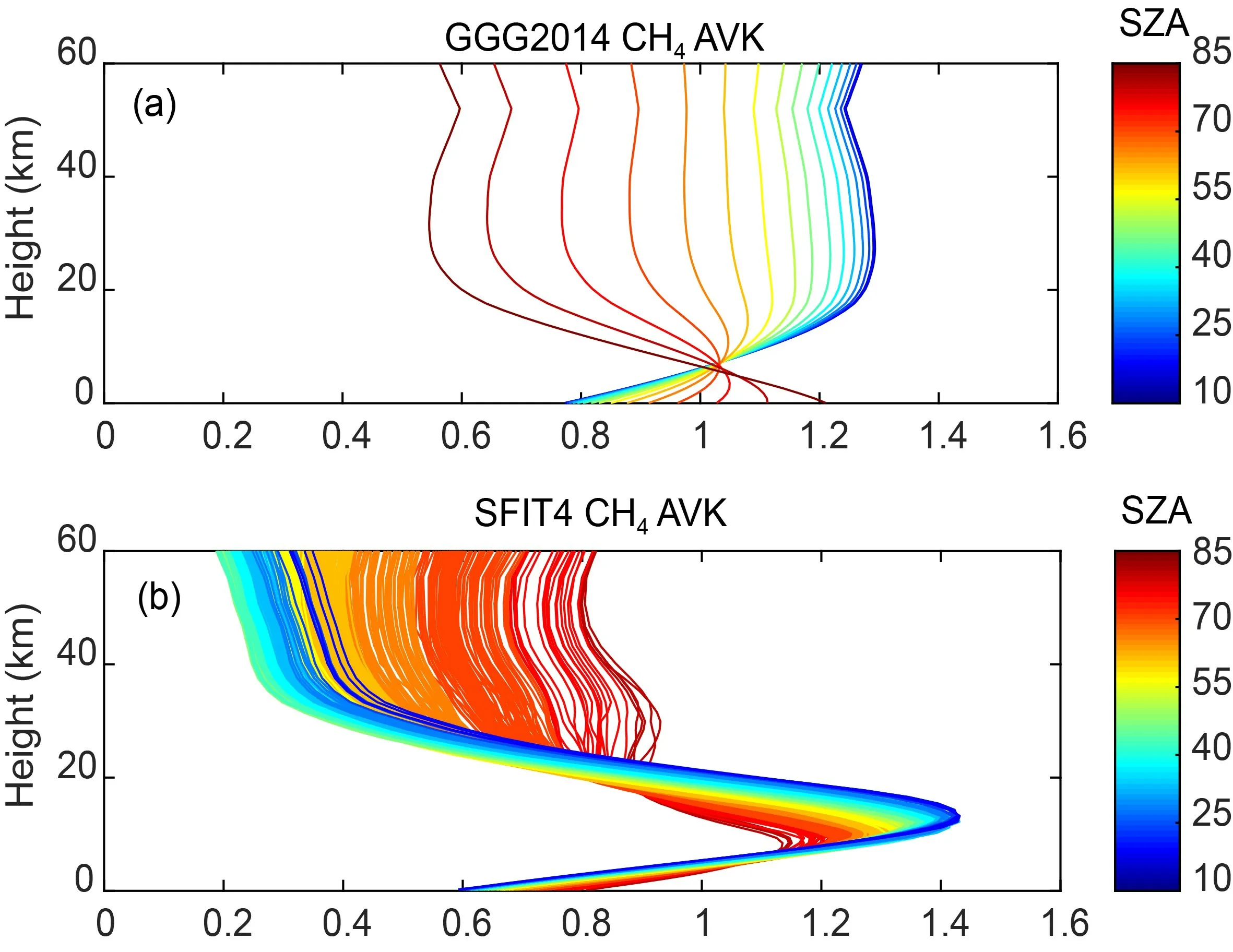
Fig. 3. Column averaging kernel (AVK) of the CH4 retrieval in the (a)GGG2014 and (b) SFIT4 codes, colored with different solar zenith angels(SZAs).
Figure 3 shows information about the AVK in GGG2014 and SFIT4 for different solar zenith angles(SZAs). The AVK represents the sensitivity of the inversion to the true state of the atmosphere (see section 3.2.1).Ideally, the AVK is an identity matrix, indicating that the inversion is sensitive to the whole atmosphere. However, in reality, the sensitivity to the atmospheric state of the AVK varies by height. For example, for TCCON, the total amount of CH4is always sensitive to the troposphere (> 0.8), regardless of SZA. However, in the stratosphere, the total amount of CH4varies from 1.2 to 0.6 as the SZA varies from 10° to 85°.
This is mainly because, as the Sun obliquely enters the atmosphere (as SZA increases), pressure broadening in the stratosphere contributes to a narrower linewidth than the saturated central region for gases with saturated absorption lines.Therefore, as the mass of air increases, the line becomes more saturated, so the AVK of the stratosphere is partially reduced, resulting in the total amount of column inversions becoming insensitive to stratospheric information. For the AVK in NDACC, the inversion CH4column mole fraction is more sensitive to the troposphere and the lower stratosphere.
In addition to the total column, SFIT4 can retrieve the partial column of CH4. The profiling capability is not only important for CH4source or sink research applications, but is also advantageous when validating column-averaged CH4obtained from satellites (Sepúlveda et al., 2014). The degree of freedom (DOF) of the NDACC-retrieved profile (from ground to the top of the atmosphere) of CH4is 2.23±0.18(1 δ), meaning that there are two independent pieces of information in the vertical distribution of CH4. According to the DOF, we divide the vertical distribution of CH4into two independent parts: one from the ground to 12.2 km (representing the troposphere), and the second from 12.2 to 60 km (representing the stratosphere). The DOF in each part is approximately 1, which means that the signal information in each part is independent (Fig. 4). We calculated the dry-air columnaveraged mole fractions of CH4in the troposphere ( XCH4,tr)a nd stratosphere ( XCH4,st) (Zhou et al., 2018), as follows:
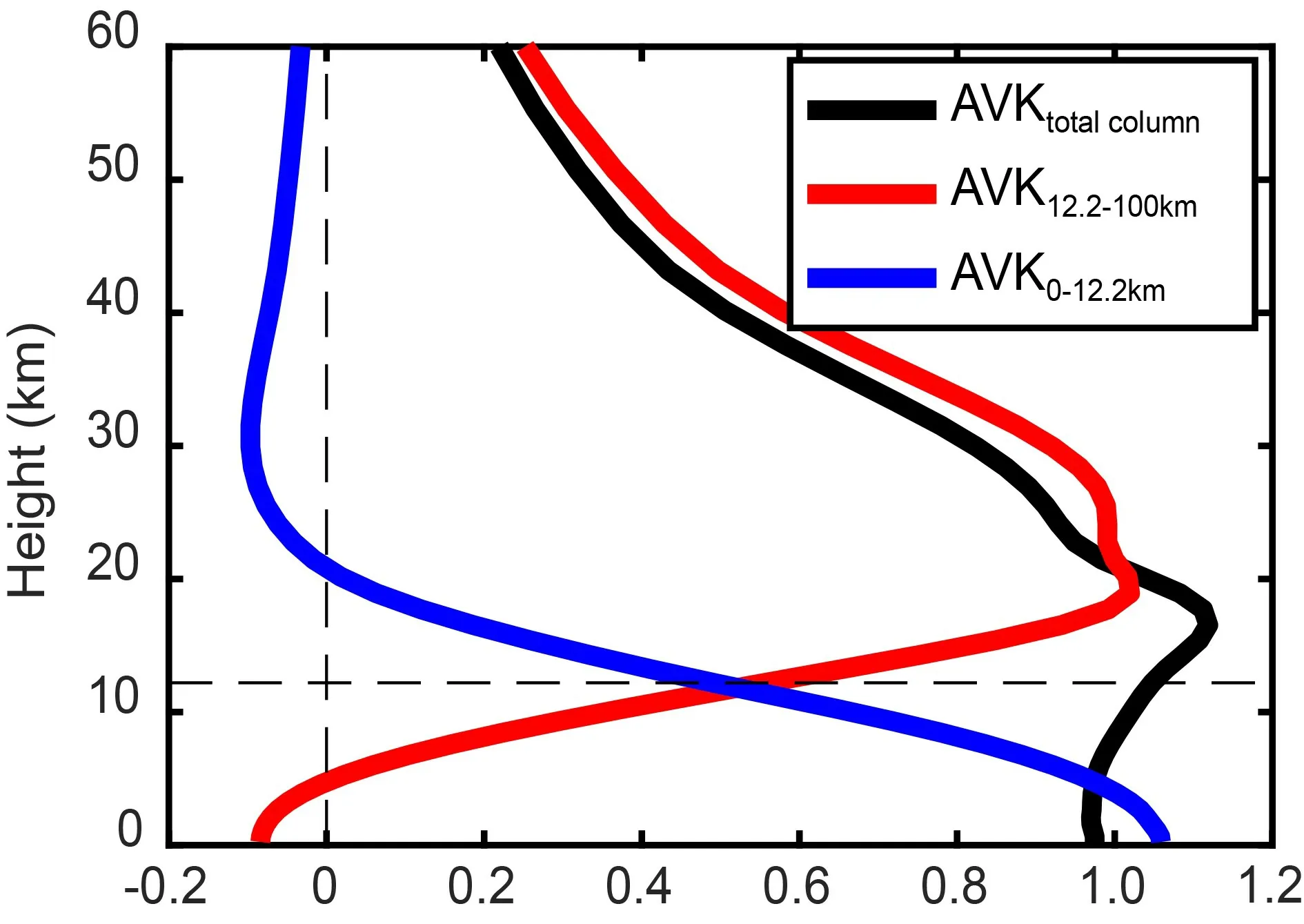
Fig. 4. Total column averaging kernel (black), together with the partial column averaging kernels of two individual layers(CH4: surface—12.2 km, partial column DOFs=1, and 12.2—60 km, partial column DOFs=1) of one typical NDACC retrieval in Xianghe.

where P CCH4,tr, P CH2O,tr, P Cair_dry,tr, and P Cair_wet,trare the partial columns of CH4, H2O, dry air, and wet air in the troposphere, and PCCH4,stand PCair_dry,stare the partial columns of CH4and dry air in the stratosphere, respectively.
Combined in-situ and FTIR measurements provided information about CH4in three vertical layers: near the ground, in the troposphere, in the stratosphere, and in the total atmospheric column. This enabled us to analyze the temporal and vertical distribution of CH4in source emission areas.
3.2.3. Uncertainty budget
TCCON is a well-developed worldwide observation network. Details of the sources of known uncertainty are described in Wunch et al. (2011). For XCH4, the largest sources of error are observer-sun Doppler stretch, shear misalignment, continuum curvature, a priori profiles, and angular misalignment. The total XCH4error, i.e., the sum of each individual uncertainty, is below 0.5% until the SZA is above ~85°. Yang et al. (2019) proved that the FTIR at the Xianghe site meets the TCCON requirements, and the instrument is in good working condition. Thus, it is reasonable to believe that the XCH4uncertainty budget of this site when using the TCCON observation mode is consistent with other TCCON sites.
For the NDACC observation mode, according to Rodgers (2000), the difference between the true and retrieved state of the atmosphere can be written as follows:

where I is the identity matrix, εbis the error in forward model parameters, and εyis the measurement error. According to Eq. (9), the total error is divided into three error sources: smoothing error, forward model parameter error,and measurement error (Senten et al. 2008). Table 2 shows the values of those errors for a regular observation. In summary, the systematic and random errors of the NDACC total column are about 3.3% and 1.7%, respectively.
3.3. The CarbonTracker-CH4 system
CarbonTracker-CH4is an assimilation system for atmospheric CH4developed by the National Oceanic and Atmospheric Administration (NOAA). Using observations from surface stations and towers, CarbonTracker-CH4assimilates global atmospheric CH4into TM5 (Transport Model 5; Liu et al., 2016). We used the current release, CT2010, to analyze the atmospheric CH4mole fractions in Xianghe at the surface. In CarbonTracker-CH4, CH4emissions into the atmosphere are estimated separately for natural and anthropogenic sources. Natural sources include oceans, wetlands,soil, and insects and wild animals. The anthropogenic sources include emissions from fires, coal, oil and gas production, animals, rice cultivation and waste. We used daily averages from 2010 to determine the contributions from different anthropogenic sources in Xianghe.
4. Results and discussion
4.1. Comparison between in-situ and FTIR total column measurements
Figure 5 shows the seasonal variation of CH4measured by the Picarro G2301 (mole fraction near the ground)and FTIR (total column-averaged dry-air mole fraction of CH4). The means (standard deviation) of the CH4mole fraction measurements are as follows: 2.2049 ppm (0.0945 ppm) for the Picarro, 1.8839 ppm (0.0129 ppm) for TCCON, and 1.9234 ppm (0.0193 ppm) for NDACC. It is clear that the mole fraction of CH4near the ground is much higher than the total column-averaged CH4. All three sets of measurements had high values in summer, later autumn,and early winter. A minimum in CH4in March and April was observed by both in-situ and FTIR measurements. The total columns of CH4based on the TCCON and NDACC measurements are similar, and the average XCH4for NDACC is about 39.5 ppb higher than TCCON. The correlation coefficient between the daily means derived from the Picarro and FTIR measurements is 0.21, indicating that the daily variation of CH4near the ground is different from that in the total column. The near-surface CH4is strongly impacted by the local emissions and sinks, while the FTIR total column amounts combine the contributions from the boundary layer, free troposphere, stratosphere, and above.
Zhang and Qun (2011) analyzed the total column amount of CH4in China using SCIAMACHY(Scanning Imaging Absorption Spectrometer for Atmospheric Chartography) satellite observations. They found that concentrations of CH4are higher in summer and lower in winter,which was attributed to biological sources in association with soil temperature and land moisture. The warm and wet soil conditions, leading to higher production in summer,provide a suitable environment for microbes to produce CH4by anaerobic respiration (Freeman et al., 2002, Hao et al., 2005, He et al., 2019). This is one possible reason for the total column amount of CH4seen in Xianghe during summer. However, the total column of CH4in Xianghe in winter was higher than that in spring. These findings indicate that the seasonal variation in total column amounts of CH4in Xianghe is not fully attributable to biological sources.
4.2. Seasonal cycle of CH4 in the troposphere and stratosphere
CH4varies with altitude, as shown in Fig. 6. In the troposphere, the average CH4concentration was 2.0599 ± 0.0224 ppm, with two maxima in August and December (2.0977 ±0.0259 and 2.0608 ± 0.0228 ppm, respectively), and two minima in October and March (2.0387 ± 0.0177 and 2.0196 ±0.0134 ppm, respectively). Compared with the in-situ measurements at the surface, CH4is much more well-mixed in the troposphere than near the surface. The variation in the tropospheric column of CH4is close to that in the in-situ measurements near the ground.In the stratosphere, the annual average CH4concentration was 1.6498 ± 0.0496 ppm, and washigher in the summer (1.7374 ± 0.0267 ppm) and lower in the winter (1.5700 ± 0.0625 ppm).

Table 2. CH4 uncertainty budget in NDACC observation mode.
Several studies show that the distribution of atmospheric trace gases is related to the Brewer—Dobson circulation (BDC); in midlatitudes, the stratosphere—troposphere exchange (STE) caused by tropopause folding can influence the vertical distribution of long-lived gases, such as CH4, N2O, and O3(Yang and Lü, 2004; Simmonds et al.,2013; Fan et al., 2014). Simmonds et al. (2013) reported that the BDC is driven by vertically propagating Rossby and gravity waves. When these waves break in the stratosphere,the speed of westerly airflow decreases, which results in high-latitude convergence and the descent of stratospheric air into the troposphere (Lu and Ding, 2013). For detailed characterization of BDC, residual circulation is often used to analyze air mass transport. Many studies have proven that such STE in midlatitudes is dominated by transportation from the stratosphere to the troposphere, which is strong in winter and spring, and weak in summer and autumn (Yang et al., 2003; Simmonds et al., 2013; Fan et al., 2014). Fan et al. (2014) showed that the center of the upwelling residual circulation at 150 hPa tends to shift northwards between April and August, and southwards between September and February of the following year. More specifically, this upwelling center can be situated at 40°N in the summer, which is very close to the study region of Xianghe.Therefore, the CH4measurements in Xianghe could provide information about CH4transport between the stratosphere and troposphere.
Figure 7 shows the annual-averaged XCH4profile in Xianghe, as well as the difference between the summer- and annual-averaged, and winter- and annual-averaged, XCH4values. There is a positive XCH4value of 0.04 ppm in summer,and a negative value of -0.05 ppm in winter. We deduce that the higher value of CH4in the stratosphere from June to August is related to upward vertical motion during that period, due to air from the troposphere entering the stratosphere and increasing the CH4mole fraction. Conversely,the lower value of stratospheric CH4in winter could be due to downward vertical motion.
In summary, we found that CH4in the troposphere was relatively well-mixed, with little variation. There were two peaks: one in the summer, caused by local sources of CH4,and one in winter, resulting from fewer hydroxyl radicals.In the stratosphere, the mixing ratio of CH4could be influenced by the STE, which reaches a maximum in summer and a minimum in winter.
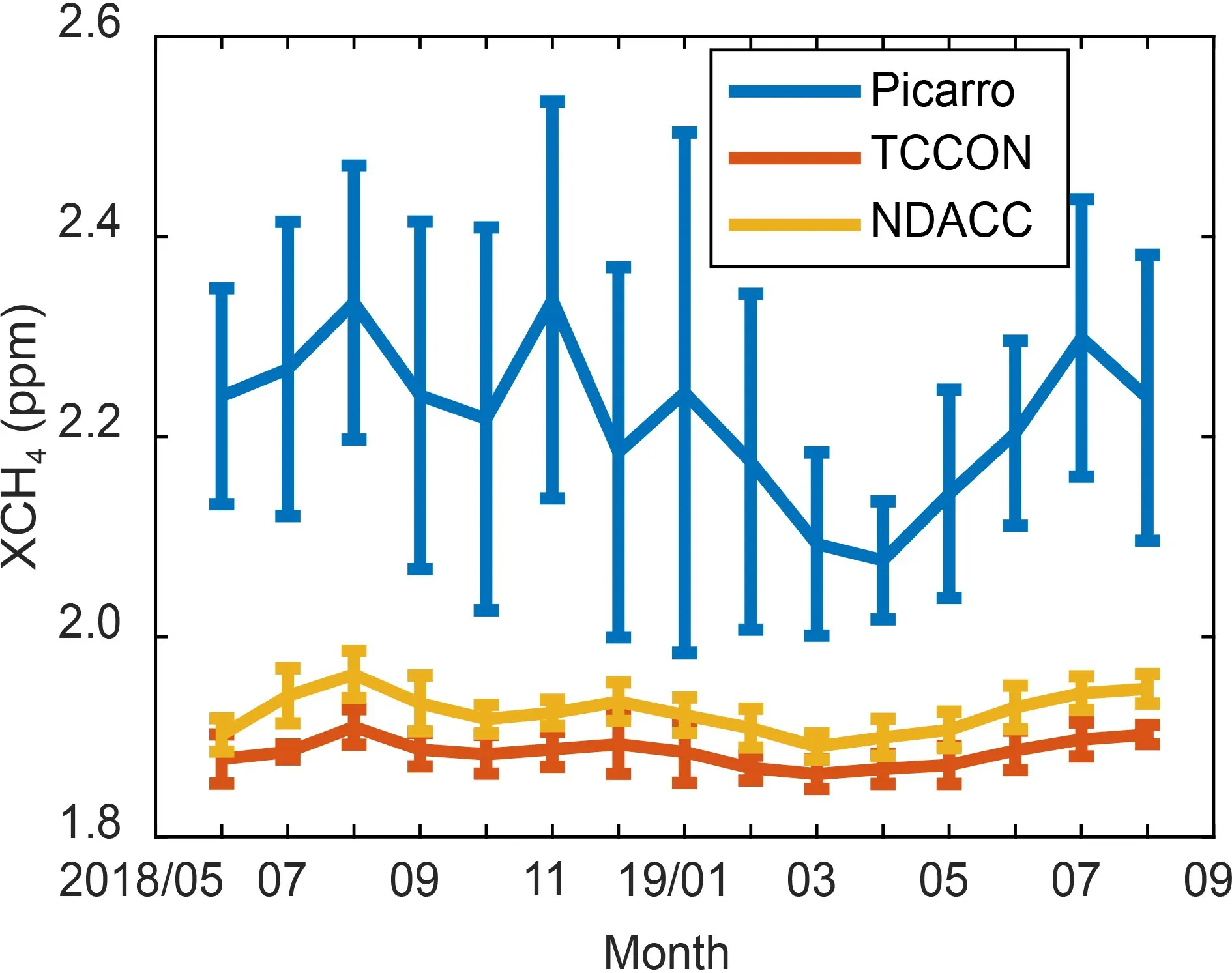
Fig. 5. Seasonal variation of CH4 measured by Picarro and FTIR. The error bar is 1 σfor all the observed data within that month.
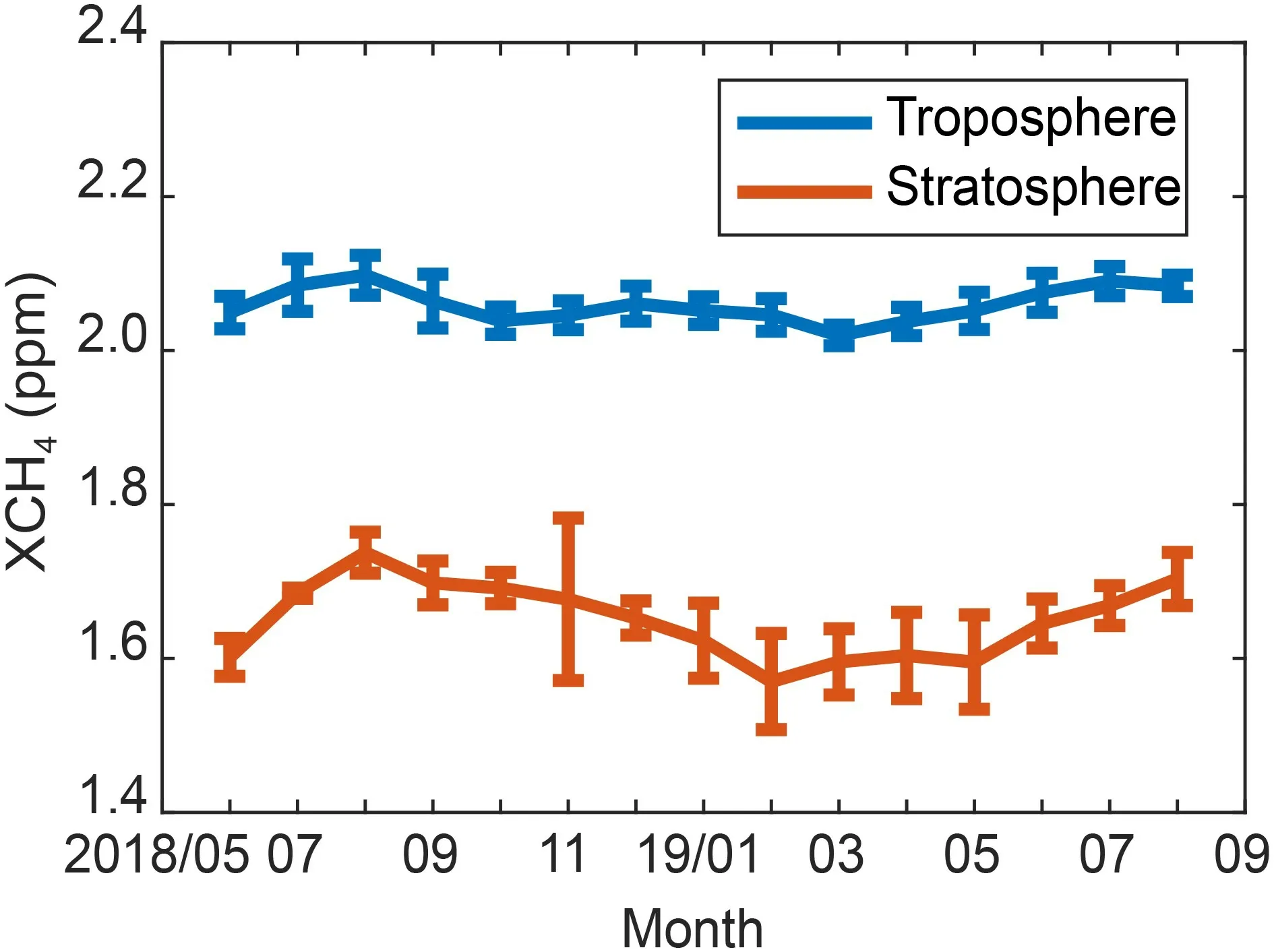
Fig. 6. Seasonal variations in two different layers: the free troposphere (blue line) and stratosphere (red line). The error bar is 1 σ for all the observed data within that month.
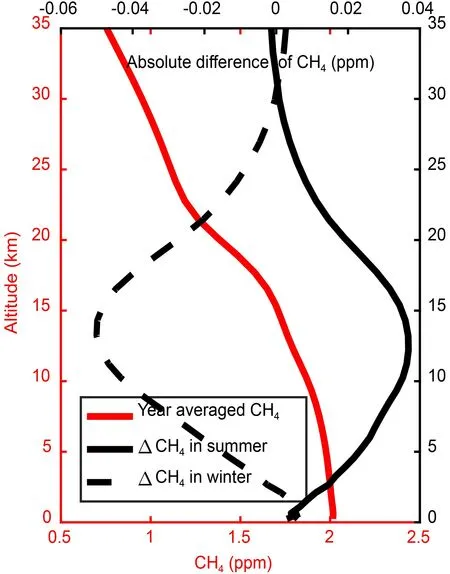
Fig. 7. The yearly averaged profile of CH4 in Xianghe (red line), and the profile of the difference between the mean CH4 profile in summer with the yearly averaged one (black solid line), and the profile of the difference between the mean CH4 profile in winter with the yearly averaged one (black dashed line).
4.3. Diurnal variation of CH4 near the ground
We mainly attribute the diurnal changes in the CH4mole fraction to three factors: local source emissions,diurnal variation of the boundary layer (which could impact the dilution of CH4), and the rate of oxidation by OH free-radicals (Fang et al., 2012). At most background stations, the CH4mole fraction is lower during the daytime than at night,since transport and photochemical sinks are more influential during the day (Fang et al., 2012). However, in some source areas, such as rice paddies, CH4emission flux increases with temperature during the daytime, reaching a maximum value at 1500LT. Thereafter, the CH4flux decreases with temperature (Lu et al., 2015).
It is obvious that, in source areas, the diurnal variation of CH4is mostly influenced by local emissions. Xianghe is a typical source area; diurnal variation of CH4from in-situ measurements at this site are shown in Fig. 8. In spring, summer, and autumn, the CH4mole fraction was higher at night(1800—0600 LT) than during the daytime (0600—1800 LT);it grows slowly but continuously, peaking at 2300 LT,before decreasing rapidly until 0600 LT the next day.However, in winter, there was no apparent difference in the CH4mole fraction between daytime and nighttime; it increased between 0600 and 1500 LT and was stable between 1500 and 2400 LT, after which it decreased as in all other seasons.
Recall that there are three factors that may affect the diurnal variation of CH4at the surface. First, OH free-radical oxidation is a relatively slow process during the day, having a rate of 360 × 1012—530 × 1012gyr-1(about 0.179 ppm yr-1);this cannot explain the observed dramatic change in CH4(Wang, 1991). Aside from during the winter, the inflexion points of the CH4signal occurred in the morning (~0600 LT) and afternoon (~1600—1700 LT). Assuming strong CH4emissions at the surface, concentrations are diluted in the deeper daytime boundary layer, whereas at nighttime CH4accumulates in the shallower boundary layer. This results in the CH4mole fraction during the daytime being lower than at night, thus showing the influence of the boundary layer on the diurnal variations of CH4.

Fig. 8. Diurnal variation of CH4 at the surface from spring to winter. The time units are in local time (+8 h UTC). The error bar is 1 σ for all the observed hourly mean data within that season at that local time.
Some studies show that the diurnal variation of emissions from landfill waste is greater at night than during the daytime (Börjesson and Svensson, 1997; Chen et al., 2008).In winter, the inflexion point was in the afternoon (~1500 LT), which is relatively different than for the other seasons.This difference may be a result of strong anthropogenic emissions at the surface close to Xianghe.
The Beijing—Tianjin—Hebei region is dominated by domestic landfill waste and wastewater treatment (Le et al.,2012; Huang et al., 2019). Huang et al. (2019) found that CH4emissions from domestic landfill waste and wastewater treatment accounts for more than 30% of total CH4emissions in Beijing and Tianjin. However, the proportion of arable land in the Beijing—Tianjin—Hebei region gradually decreased between 1990 and 2015, by about 50% (Gong et al., 2019). Therefore, CH4emission sources may have changed as arable land availability decreased, and as wastewater and domestic garbage treatment increased. Also, in 2018, a new domestic waste site was created about 8 km away from the Xianghe site. We deduce that CH4emissions in Xianghe are most likely related to domestic landfill waste and wastewater treatment. Further investigation is needed to understand the diurnal variation of emissions, which in turn could help us to better understand the diurnal variation of CH4in particular.
4.4. CarbonTracker-CH4 model simulations
We used CarbonTracker model simulations to analyze emission contributions from different sources in Xianghe.Figure 9a shows the seasonal variation of the CH4mole fraction in 2010 from six different sources: fossil fuels;insects/wild animals; rice cultivation and waste; wetlands and soil; oceans; and wildfires. Fossil fuels, wildfires, and oceans are not as important as the other sources, only accounting for about 15% of total emissions in Xianghe. The most important sources are animals, rice cultivation, and waste,which accounted for about 32.6% of the total emissions.
The largest seasonal variation in emissions was found for wetlands, soil, oceans, and insects/wild animals; emissions were higher in the summer (~700 ppb in August) and lower in other seasons (~420 ppb). This helps explain the relatively high values measured in-situ, especially in August.A small peak in December for agriculture waste was simulated, which may explain the measured peak of the CH4mole fraction near the surface at this time.

Fig. 9. Model results of (a) seasonal variation of the mean and standard deviation of CH4 mole fraction near the surface due to different sources, wherein the dark blue line represents emissions from fossil fuels, the red line represents emissions from animals, rice cultivation and waste, the yellow line represents natural emissions from wetlands, soil, oceans and insects/wild animals, the purple line represents emissions from the oceans, and the light blue line represents emissions from fires. The error bar is 1 σ for all the simulated daily mean data within that season; and (b) daily variation of the CH4 near the surface from spring to winter. The time units are local time (+8 h UTC).The error bar is 1 σ for all the simulated hourly mean data within that season at that local time.
According to the modeled diurnal variation of the CH4mole fraction (Fig. 9b), maximum values occurred every day at 0800 LT from spring to winter; this was not shown by the in-situ measurements. Since the model simulation was for 2010 (about nine years ago at the time of writing),sources of CH4may have changed greatly, especially with regard to domestic landfill waste and wastewater treatment,which has recently played a more important role.
5. Conclusions
Atmospheric CH4mole fractions were measured by insitu and FTIR instruments in Xianghe beginning in June 2018. In-situ observations provided information near the ground, and FTIR measurements provided information on total column values of CH4, as well as partial columns in the troposphere and stratosphere, based on TCCON and NDACC measurements.
The mean (standard deviation) of the CH4mole fraction near the ground measured by the Picarro instrument was 2.2049 ppm (0.0945 ppm). The mean (standard deviation) XCH4measured by FTIR was 1.8839 ppm (0.0129 ppm) based on TCCON data and 1.9234 ppm (0.0193 ppm)based on NDACC data. The CH4mole fraction near the ground was about 13% larger than for XCH4, since there are strong CH4emissions at the surface near Xianghe. The CH4mole fraction in the stratosphere was much lower than that in the troposphere. Similar seasonal variations of CH4were found near the ground, in the troposphere, and in the stratosphere. The CH4mole fraction in the stratosphere appeared to change with season, which could be due to the influence of STE.
The CH4mole fraction near the ground reached its maximum value near midnight (~2200—2300 LT), with its minimum value occurring at 0600—0700 LT. The daily maximum values in summer were relatively higher than in other seasons, at nearly 2.4 ppm.
Comparing CarbonTracker-CH4model simulations with our observations near the ground in Xianghe, we found that the model can reproduce the peak value of the CH4mole fraction in summer, but underestimates the peak value in winter. The modeled and measured daily variation of the CH4mole fraction differed.
In summary, we analyzed the temporal and vertical distributions of CH4in source emission areas using Picarro and FTIR measurements. The vertical distributions could be very useful for understanding the source emissions at such a polluted site.
Acknowledgements.This research was funded by the National Key R&D Program of China (Grant Nos. 2017YFB 0504000 and 2017YFC150 1701) and the National Natural Science Foundation of China (Grant No. 41975035). We want to thank the TCCON community for sharing the GGG2014 retrieval code, the NDACC community for sharing the SFIT4 retrieval code, and NOAA for providing the CarbonTracker-CH4Data Assimilation Product. We also want to thank Weidong NAN, Qing YAO, and Qun CHEN (Xianghe site) for the maintenance of the in-situ and FTIR measurements at Xianghe.
 Advances in Atmospheric Sciences2020年6期
Advances in Atmospheric Sciences2020年6期
- Advances in Atmospheric Sciences的其它文章
- Estimate of Hydrofluorocarbon Emissions for 2012-16 in the Yangtze River Delta, China
- Comparison of Ozone Fluxes over a Maize Field Measured with Gradient Methods and the Eddy Covariance Technique
- Direct Observations of Atmospheric Transport and Stratosphere-Troposphere Exchange from High-Precision Carbon Dioxide and Carbon Monoxide Profile Measurements
- An Observing System Simulation Experiment to Assess the Potential Impact of a Virtual Mobile Communication Tower-based Observation Network on Weather Forecasting Accuracy in China. Part 1: Weather Stations with a Typical Mobile Tower Height of 40 m
- On the Epochal Variability in the Frequency of Cyclones during the Pre-Onset and Onset Phases of the Monsoon over the North Indian Ocean
- Relationship between Solar Wind-Magnetosphere Energy and Eurasian Winter Cold Events
